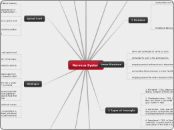Nervous System
5 Characteristics of Neurons
extreme longevity - lives a long time(your life span)
amniotic - do not divide; won't be replaced
high metabolic rate - chemical reations are happening very quickly
excitable - sensitive to changes in environment and pH is relevant(acidosis depresses, alkalosis excites)
conductivity - transmits impulses from one nerve to another
Myelin Formation
made up of phospholipids(fat) - protein and cholesterol
myelinated axons - white matter unmyelinated axons - grey matter
all Schwann cells together form myelin
node of Ranvier (ron-vee-ay) - important when transmitting & conducting impulses along the axon
Nervous Tissue
neuron - entire (single) cell
neuroglia - netted support tissue for neuron
located in spinal cord, brain, and nerves (these are made up of nervous tissue)
2 Divisions
Central Nervous System (CNS)
brain
spinal cord
Peripheral Nervous System (PNS)
all other nerves
12 pairs of cranial nerves
spinal nerves
sensory division - input of receptors
motor division - somatic and autonomic nervous systems
Nerve Structure
nerve cell connected to nerve by axon
connected to axon is the endoneurium
wrapping around endoneurium is the perineuium
surrounding the perineuium is many fasicles
wrapping around the entire structure is the epineurium
5 Types of Neuroglia
1. Microglial - CNS; phagocytize(eat) cell bacteria & cell debris; numbers of these will increase when infection arises
2. Oligodendrocytes - CNS; form myelin in CNS; wherever they are, there is also white matter; without them, there is gray matter in CNS
3. Astrocytes - CNS; star-shaped, large cells with processes that come in contact with blood capillaries & neuron; handle exchange/transport of substances between blood & neuron
4. Ependymal - CNS; in fluid-filled cavities of brain are ventricles, in spinal cord is central canal; controls composition of this fluid & circulate the cerebrospinal fluid
5. Schwann - PNS; only cell of Perioheral Nervous System
Cerebrospinal Fluid
clear, viscous(thick) fluid secreted by choroid plexus into subarachnoid space
functions: maintain stable ionic concentrations for CNS; protective cushion
secretes 500 ml; only 140 ml present in a day, rest of it goes to sinuses
spinal tap/lumbar puncture - between L3 and L4 vertebrae(below spinal cord); goes into subarachnoid space and examines fluid for infection
hydrocephaly - "water on the brain"; fontanel membrane has not ossified * so it keeps stretching to fit the liquid and head is very large; fluid must be removed by channeling the fluid out and into a tube in the neck
Reflex Arc
direct route from sensory nueron to effectors(always travels the same path); rapid, predictable, involuntary response
example: hitting the patellar ligament on knee; simplest of all reflexes, same thing happens everytime, same action that cannot be controlled
ex: feel something burning, pulls hand away asap
ex: step on a tac, lifts foot immediately
Ventricles & Location of Cerebro Spinal Fluid
4 ventricles(fluid-filled sacs with CSF) in brain
location: ventricles, central canal(SC), & subarachnoid space
Spinal Cord
from foramen magnum to vertebral foramen
2 functions: spinal reflexes; conduct ascending(sensory) -posterior entry is also sensory; descending tracts(motor) - anterior exit is also motor
nerves - only in PNS, not in brain or spinal cord vs. tracts - only in CNS
ganglion - clusters of cell bodies(neurons) forms swollen area on dorsal in PNS vs. nuclei - clusters of cell bodies in CNS
Meninges
meninges - protective covering for brain and spinal cord
meningitis - inflamation of meninges
looks like a sac that covers brain & ic connected to bone & christa galli
outside part of meninges is called Dura Mater(outermost layer of meninges under subdural space); closest to skull
Arachnoid Mater - 2nd, mid layer; web-like, thin like a spider web, beneath is subarachnoid space with CSF circulating
innermost layer of meninges is Pia Mater; covers brain like shrink wrap in all sulcus & sulci; contains blood capillaries known as choroid plexus that make cerebrospinal fluid that circulates above the Pia Mater; closest to brain
transverse & sagittal sinus that are flattened blood vessels
Spinal Cord: meninges are in the same order except there is an epidural space between the bone & Dura Mater with blood vessels running through it(where epidurals are administered)
Functional Classification of Neurons
sensory(afferent) - approaching, entering; goes into back of spinal cord(dorsal)
interneuron - between sensory & motor neurons; totally enclosed in CNS; routes impulses where they need to go
motor(efferent) - outward, away; exciting; ventral, comes out front of spinal cord
Neuron Structure
dendrites - recieving portion(impulses from other neurons) are seen as projections off of cell body
cell body - has typical cell structures
axon - connects cell body to axon terminals(with synaptic vesicles inside); carries impulses away from cell body to axon terminals
Schwann cell - type of neuroglia(only found in PNS - Peripheral Nervous System)
